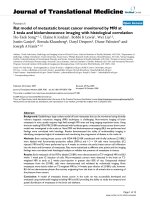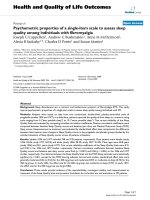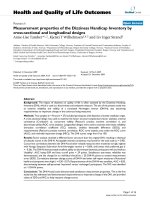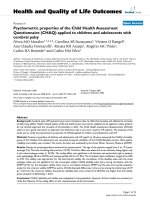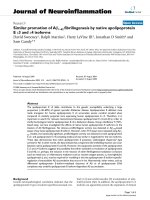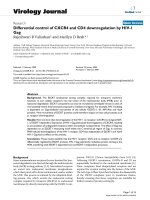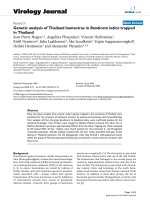Báo cáo hóa học: " Thermoelectric properties of Ca0.8Dy0.2MnO3 synthesized by solution combustion process" pptx
Bạn đang xem bản rút gọn của tài liệu. Xem và tải ngay bản đầy đủ của tài liệu tại đây (689.84 KB, 5 trang )
NANO EXPRESS Open Access
Thermoelectric properties of Ca
0.8
Dy
0.2
MnO
3
synthesized by solution combustion process
Kyeongsoon Park
*
and Ga Won Lee
Abstract
High-quality Ca
0.8
Dy
0.2
MnO
3
nano-powders were synthesized by the solution combustion process. The size of the
synthesized Ca
0.8
Dy
0.2
MnO
3
powders was approximately 23 nm. The green pellets were sintered at 1150-1300°C at
a step size of 50°C. Sintered Ca
0.8
Dy
0.2
MnO
3
bodies crystallized in the perovskite structure with an orthorhombic
symmetry. The sintering temperature did not affect the Seebeck coefficient, but significantly affected the electrical
conductivity. The electrical conductivity of Ca
0.8
Dy
0.2
MnO
3
increased with increasing temperature, indicating a
semiconducting behavior. The absolute value of the Seebeck coefficient gradually increased with an increase in
temperature. The highest power factor (3.7 × 10
-5
Wm
-1
K
-2
at 800° C) was obtained for Ca
0.8
Dy
0.2
MnO
3
sintered at
1,250°C. In this study, we investigated the microstructure and thermoelectric properties of Ca
0.8
Dy
0.2
MnO
3
,
depending on sintering temperature.
Keywords: electrical conductivity, solution combustion process, Seebeck coefficient, power factor, Ca
0.8
Dy
0.2
MnO
3
1. Introduction
Solid-state thermoelectric p ower generation based on
Seebeck effects has potential a pplications in waste-heat
recovery. Thermoelectric generation is the rmodynami-
cally similar to conventional vapor power generation or
heat pumping cycles [ 1]. Thermoelectric devices are not
complicate, have no moving parts, and use electrons as
working fluid instead of physical g ases or liquids [1,2].
The efficiency of thermoelectric devices is determined
by the materials’ dimensionless figure-of-merit, defined
as ZT = sa
2
/T,wheres, a, ,andT are the electrical
conductivity, Seebeck coefficient, thermal conductivity,
and absolute temperature, respectively. To be a good
thermoelectric material, it is required t o have a large
electrical conductivity and See beck coefficient as we ll as
a low thermal conductivity. The three parameters
depend on each other since they are closely related to
the scattering of charge carriers and lattice vibrations. It
is thus necessary to compromise among them for opti-
mizing the thermoelectric properties [3].
Kobayashi et a l. [4] proposed the possibility of (R
1-
x
Ca
x
)MnO
-δ
(R: Tb, Ho, and Y) with the orthorhombic
perovskite-type structure as n-type thermoelectric
materials. Since then, the electrical transport properties
of (Ca
0.9
M
0.1
)MnO
3
(M=Y,La,Ce,Sm,In,Sn,Sb,Pb,
and Bi) have been studied, and reported that partial sub-
stitution for the Ca led to a significant increase in the
electrical conductivity, along with a moderate decrease
in the absolute value of the Seebeck coefficient, thereby
improving the dimensionless figure-of-merit [3].
It is well known that control ling the microstructure
and processing, especially sintering, is a feasible route to
improve the thermoelectric performance. Therefore, in
this study, to improve the thermoelectric properties,
nano-sized Ca
0.8
Dy
0.2
MnO
3
powders were synthesized
by the solution combustion process. The solution com-
bustion process is favorable for synthesizing pure and
nano-sized high-quality oxide powders in a short time
and is cost-effective [5,6]. Subsequently, we sintered the
Ca
0.8
Dy
0.2
MnO
3
green pellets at 1150-130 0°C and then
investigated the microstructure and thermoelectric prop-
erties, depending on sintering temperature.
2. Experimental
Ca
0.8
Dy
0.2
MnO
3
powders were synthesized by the solu-
tion combustion process. The process involved the
exothermic reaction initiated by metal nitrates (oxidizer)
and an organic fuel (reductant). Ca(NO
3
)
2
·6H
2
O, Mn
(NO
3
)
2
·6H
2
O, Dy(NO
3
)
3
·5H
2
O were used as oxidizers
* Correspondence:
Faculty of Nanotechnology and Advanced Materials Engineering, Sejong
University, Seoul 143-747, Korea
Park and Lee Nanoscale Research Letters 2011, 6:548
/>© 2011 Park and Lee; licensee Springer. This is an Open Access article distributed und er the terms of the Creative Commons
Attribution License (http://creativecom mons.org/licenses/by/2.0), w hich permits unrestricted use, distribution, and repro duction in
any medium, provided the original work is properly cited.
and glutamic acid (C
5
H
9
NO
4
) as combustion fuel. The
molar ratio of the metal nitrates to the fuel in the pre-
cursor solution was adjusted t o be 1:1. The appropriat e
proportions of the me tal nitrates were separately dis-
solved in distilled water to prepare homogeneous solu-
tions. The glutamic acid was separately dissolved in the
solutions. The re sulti ng solution was heated slowly on a
hot plate, boiled, and dehydrated, forming a highly vis-
cous gel. Subsequent ly, the gel frothed and swelled with
evolution of huge volume of gases. The reaction lasted
for 3-4 min and produc ed a foam that readily crumbl ed
into powder. The size and mor phology of the resulting
powders were characterized with a transmission electron
microscope (TEM; JEOL JEM-2100F) operating at 200
kV. Subsequently, the synthesized powders were cal-
cined at 900 and 1,000°C for 12 h with intermediate
grinding. The calcined nanopowders were cold-pressed
under 137 MPa to prepare green pellets. The pellets
were sintered at 1150-1300°C at a step of 50°C in air.
The porosity of as-sintered Ca
0.8
Dy
0.2
MnO
3
was mea-
sured by the Archimedes’ principle. The crystal struc-
ture of as-sintered samples was analyzed with an X-ray
diffractometer (XRD; Rigaku DMAX-2500) using Cu Ka
radiation at 40 kV and 100 mA. The microstructure of
as-sintered samples was investigated with a field emis-
sion scanning electron microscope (FESEM; Hitachi
S4700). To measure the thermoelectric properties as a
function of temperature, the electrical conductivity s
and the Seeb eck coefficient a were simultaneously mea-
sured over a temperature range of 500-800°C.
Samples for the measurements of thermoelectric prop-
erties were cut out of the sintered bodies in the form of
rectangular bars of 2 × 2 × 15 mm
3
with a diamond saw
and polished with SiC emery paper. The electrical con-
ductivity s was measured by the direct current (dc)
four-probe method. For thermopower measurements, a
temperature difference Δ T in the sample was generated
by passing cool Ar gas over one end of the sample
placed inside a quartz protection tube. The temperature
difference ΔT between the two ends of each sample was
controlled at 4-6°C by varying the flowing rate o f Ar
gas. The thermoelectric voltage ΔE measured as a func-
tion of the temperature difference ΔT gave a straight
line. The Seebeck coefficient a was calculated from the
relation a = ΔE/ΔT.
3. Results and discussion
Figure 1 shows a TEM bright-field image of the synthe-
sized Ca
0.8
Dy
0.2
MnO
3
powders. The synthesized
Ca
0.8
Dy
0.2
MnO
3
powders show spherical and regular
morphologies, and smooth surfaces. The average size of
the synthesized powders is in nano-scale, i.e., approxi-
mately 23 nm. Obviously, this combustion processing is
an extremely simple and cost-effective method for
preparing Ca
0.8
Dy
0.2
MnO
3
nanopowders, compared to
conventional solid-state reaction processing.
Figure 2a-d represents FESEM images obtained from
the surfaces of Ca
0.8
Dy
0.2
MnO
3
sintered at 1150, 1200,
1250, and 1300°C, respectively. Most pores are located
at the grain boundaries. As the sintering temperature
increases, the average grain size of the samples
increases, i.e., 399, 430, 545, and 590 nm for 1150, 1200,
1250, and 1300°C, respectively. In addition, the density
of the samples escalates with an increase in sintering
temperature up to 1250°C, and then decreases with a
Figure 1 TEM bright-field image of synthesized Ca
0.8
Dy
0.2
MnO
3
powders.
Figure 2 FESEM images obtained from the surfaces of
Ca
0.8
Dy
0.2
MnO
3
sintered at (a) 1150, (b) 1200, (c) 1250, and (d)
1300°C.
Park and Lee Nanoscale Research Letters 2011, 6:548
/>Page 2 of 5
further rise in sintering temperature. The densities of
Ca
0.8
Dy
0.2
MnO
3
sintered at 1150, 1200, 1250, and 1300°
C are 81.5, 87.2, 98.5, and 96.3% of the theoret ical den-
sity, respectively. A fine-grain size and high density are
obtained even at a low sintering temperature of 1250
and 1300°C. This indicates that nano-sized powders
synthesized by the glutamic acid-assisted combustion
method allow for dense and fine-grained pellets at much
lower sintering temperature, compared to conventional
solid-state reaction processed powders. The finer pow-
der has a larger surface energy, thus giving rise to larger
densification and grain growth rates because of a high
diffusivity near the surface and grain boundary during
sintering [7].
The XRD patterns o f the Ca
0.8
Dy
0.2
MnO
3
sintered at
various temperatures are shown in Figure 3. The sin-
tered Ca
0.8
Dy
0.2
MnO
3
has an orthorhombic perovskite-
type structure, belonging to the Pnma space group [8].
The added Dy
3+
does not affect the crystal structure of
CaMnO
3
. The crystallite size D of the Ca
0.8
Dy
0.2
MnO
3
pellets can be calculated from the Scherrer formula: D =
(0.9l)/(bcosθ), where l is the wavelength of radiation, θ
is the angle of the diffraction peak, and b is the full
width at half maximum of the diffraction peak (in
radian) [9]. The calculated crystallite sizes of the sin-
tered Ca
0.8
Dy
0.2
MnO
3
are in the range of 20.0-24.5 nm.
The electrical conductivity of Ca
0.8
Dy
0.2
MnO
3
sintered
at various temperatures is shown in Figure 4. The elec-
trical conductivity increases with increasing temperature,
indicating a typical semiconducting behavior characteris-
tic. In addition, the electrical conductivity increases with
increasing sintering temperature, reaching a maximum
at 1250°C, and then decreases with further increasing
sintering temperature. The electrical conductivities at
800°C for the Ca
0.8
Dy
0.2
MnO
3
samples sintered at 1150,
1200, 1250, and 1300°C are 82.8, 88.3, 120.5, and 96.6
Ω
-1
cm
-1
, respe ctively. The electrical conducti vity of the
Ca
0.8
Dy
0.2
MnO
3
sintered at 1300°C is lower than that of
the Ca
0.8
Dy
0.2
MnO
3
sintered at 1250°C. This result indi-
cates that the porosity strongly affects the electrical con-
ductivity of Ca
0.8
Dy
0.2
MnO
3
. Pores act as scattering
centers for conduction, decreasing the time between
electron scattering events of charge carriers. The highest
electrical conductivity (1 20.5 Ω
-1
cm
-1
) is obtained for
the Ca
0.8
Dy
0.2
MnO
3
sintered at 1250°C.
A relationship between the log(sT) and 1000/T for
Ca
0.8
Dy
0.2
MnO
3
as a function of sintering temperature
is shown in Figure 5. We c an find a nearly linear rela-
tionship between log(sT) and 1000/T over the measured
temperature range. The activation energy (E
a
)forcon-
duction at high temperatures (500-800°C) is calculated
from the slope o f the log(sT) and 1000/T .The
Figure 3 XRD patterns of Ca
0.8
Dy
0.2
MnO
3
sintered at various
temperatures.
Figure 4 Electrical conductivity of Ca
0.8
Dy
0.2
MnO
3
sintered at
various temperatures.
Figure 5 A relationship between the log(sT) and 1000/T for
Ca
0.8
Dy
0.2
MnO
3
as a function of sintering temperature.
Park and Lee Nanoscale Research Letters 2011, 6:548
/>Page 3 of 5
calculated activation energies of the Ca
0.8
Dy
0.2
MnO
3
sintered at 1150, 1200, 1250, and 1300°C are 0.096,
0.126, 0.115, and 0.104 eV, respectively. This means that
the conduction of these samples is caused by a ther-
mally activated small polaron hopping [10]. A small
polaron is formed when the effective m ass of the rigid
lattice hole is large and coupling to optical phonons is
strong [11].
In the polaron hopping conduction, an electron moves
by a thermally activated hopping process from one loca-
lized state to another with the activation energy E
h
[12].
The electrical conductivity s is written as s =(C/T)exp
(-E
h
/k
B
T), where C, T, E
h
,andk
B
are the charge carrier
concentration, the absolute t emperature, the activation
energy, and the Boltzmann constant, respectively [3].
The electrical conductivity of the small polaron hopping
conduction in the adiabatic case is given as s = neμ =
nea
2
(A/T)exp(-E
h
/k
B
T), where n is the carrier concentra-
tion, e is the electrical charge of the carrier, μ is the car-
rier mobility, a is the intersite distance of hopping, E
h
is
the activation energy for hopping, and A is the pre-
exponential tern related to the carrier scattering
mechanism, respectively [3,13].
The Seebeck coefficient of Ca
0.8
Dy
0.2
MnO
3
as a func-
tion of temperature is shown in Figure 6, depending on
sintering temperature. The absolute value of the Seebeck
coefficient for Ca
0.8
Dy
0.2
MnO
3
gradually increases with
an increase in temperature. The sign of the Seebeck
coefficient is negative over the measured temperature
range, indicating n-type conduction. The absolute values
of the Seebeck coefficients at 800°C for the
Ca
0.8
Dy
0.2
MnO
3
sintered at 1150, 1200, 1250, and 1300°
C are 55.0, 54.7, 55.1, and 54.9 μVK
-1
, respectively,
indicating sintering temperature has no significant influ-
ence on the Seebeck coefficient.
The power factor sa
2
is calculated using the electrical
conductivity s and the Seebeck coefficient a. The power
factor obtained from the data in Figures 4 and 6 is
plotted in Figure 7. At a given sintering temperature,
the power factor increases with an increase in tempera-
ture. In addition, the power factor increases with sinter-
ing temperature up to 1250°C and then decreases for
higher sintering temperature. The highest power factor
(3.7 × 10
-5
Wm
-1
K
-2
at 800°C) is obtained for the
Ca
0.8
Dy
0.2
MnO
3
sintered at 1250°C. From the above
results, it is believed that controlling the sintering tem-
perature of Ca
0.8
Dy
0.2
MnO
3
is important for imp rov ing
its thermoelectric properties.
4. Conclusion
We synthesized Ca
0.8
Dy
0.2
MnO
3
nanopowders (approxi-
mately 23 nm in size) , which showed spherical and reg-
ular morphologies, and smooth surfaces, by the glutamic
acid-assisted combustion method. The nano-sized pow-
ders led to dense and fine-grained pellets at low sinter-
ing temperature. The average grain sizes of the
Ca
0.8
Dy
0.2
MnO
3
sintered at 1150, 1200, 1250, and 1300°
C wer e 399, 430, 545, and 590 nm, respec tively. In addi-
tion, the densities of the Ca
0.8
Dy
0.2
MnO
3
sintered at
1150, 1200, 1250, and 1300°C were 81.5, 87.2, 98.5, and
96.3% of the theoretical density, respectively. The
Ca
0.8
Dy
0.2
MnO
3
sintered had an orthorhombic perovs-
kite-type structure, belonging to the Pnma space group.
The electrical conductivity increased with increasing sin-
tering temperature, reaching a maximum at 1250°C, and
then decreased with further increasing sintering tem-
perature. However, a noticeable change in the Seebeck
coefficient of Ca
0.8
Dy
0.2
MnO
3
sintered at various tem-
peratures was not evident. The Ca
0.8
Dy
0.2
MnO
3
sintered
at 1250°C showed the highest power factor (3.7 × 10
-5
Figure 6 Seebeck coefficient of Ca
0.8
Dy
0.2
MnO
3
as a function of
temperature.
Figure 7 PowerfactorofCa
0.8
Dy
0.2
MnO
3
sintered at various
temperatures.
Park and Lee Nanoscale Research Letters 2011, 6:548
/>Page 4 of 5
Wm
-1
K
-2
) at 800°C. It is necessary to control the sinter-
ing temperature of Ca
0.8
Dy
0.2
MnO
3
for improving the
thermoelectric properties.
Acknowledgements
This study is the outcome of a Manpower Development Program for Energy
& Resources supported by the Ministry of Knowledge and Economy (MKE),
Republic of Korea.
Authors’ contributions
KP conceived of the study, participated in its design and coordination, and
drafted the manuscript. GWL carried out the synthesis, microstructure
analysis, and thermoelectric studies. All authors read and approved the final
manuscript.
Competing interests
The authors declare that they have no competing interests.
Received: 25 May 2011 Accepted: 5 October 2011
Published: 5 October 2011
References
1. Heremans JP, Jovovic V, Toberer ES, Saramat A, Kurosaki K,
Charoenphakdee A, Yamanaka S, Snyder GJ: Enhancement of
thermoelectric efficiency in PbTe by distortion of the electronic density
of states. Science 2008, 321:554-557.
2. Sales BC: Smaller is cooler. Science 2002, 295:1248-1249.
3. Ohtaki M, Koga H, Tokunaga T, Eguchi K, Arai H: Electrical transport
properties and high-temperature thermoelectric performance of
(Ca
0.9
M
0.1
)MnO
3
(M = Y, La, Ce, Sm, In, Sn, Sb, Pb, Bi). J Solid State Chem
1995, 120:105-111.
4. Kobayashi T, Takizawa H, Endo T, Sato T, Shimada M, Taguchi H, Nagao M:
Metal-insulator transition and thermoelectric properties in the system
(R
1-x
Ca
x
)MnO
3-δ
(R: Tb, Ho, Y). J Solid State Chem 1991, 92:116-129.
5. Kingsley JJ, Suresh K, Patil KC: Combustion synthesis of fine-particle metal
aluminates. J Mater Sci 1990, 25:1305-1312.
6. Colomer MT, Fumo DA, Jurado JR, Segadaes AM: Non-stoichiometric La
(1-x)
NiO
(3-δ)
pervoskites produced by combustion synthesis. J Mater Chem
1999, 9:2505-2510.
7. Park K, Hwang HK: Electrical conductivity of Ce
0.8
Gd
0.2-x
Dy
x
O
2-δ
(0 ≤ × ≤
0.2) co-doped with Gd
3+
and Dy
3+
for intermediate-temperature solid
oxide fuel cells. J Power Sources 2011, 196:4996-4999.
8. Itoh T, Terasaki I: Thermoelectric properties of Bi
2.3-x
Pb
x
Sr
2.6
Co
2
O
y
single
crystals. Jpn J Appl Phys 2000, 39:6658-6660.
9. Ainirad A, Kashani Motlagh MM, Maghsoudipoor A: A systematic study on
the synthesis of Ca, Gd codoped cerium oxide by combustion method. J
Alloys Compd 2011, 509:1505-1510.
10. Gutierrez D, Peña O, Duran P, Moure C: Crystal structure, electrical
conductivity and Seebeck coefficient of Y(Mn,Ni)O
3
solid solutions. J Eur
Ceram Soc 2002, 22:567-572.
11. Karim DP, Aldred AT: Localized level hopping transport in La(Sr)CrO
3
. Phys
Rev B 1979, 20:2255-2263.
12. Austin IG, Mott NF: Polarons in crystalline and non-crystalline materials.
Adv Phys 1969, 18:41-102.
13. Tuller HL, Nowick AS: Small polaron electron transport in reduced CeO
2
single crystals. J Phys Chem Solids 1977, 38:859-867.
doi:10.1186/1556-276X-6-548
Cite this article as: Park and Lee: Thermoelectric properties of
Ca
0.8
Dy
0.2
MnO
3
synthesized by solution combustion process. Nanoscale
Research Letters 2011 6:548.
Submit your manuscript to a
journal and benefi t from:
7 Convenient online submission
7 Rigorous peer review
7 Immediate publication on acceptance
7 Open access: articles freely available online
7 High visibility within the fi eld
7 Retaining the copyright to your article
Submit your next manuscript at 7 springeropen.com
Park and Lee Nanoscale Research Letters 2011, 6:548
/>Page 5 of 5
